While some caterpillars are harmless and can be handled freely, others are dangerous to touch altogether. Because they produce and inject their toxins into their victims, they are considered venomous rather than poisonous. These venomous caterpillars will not bite but possess sharp defensive spines that they use to defend themselves against predators. In this article, we’ll talk about ten of the most interesting stinging caterpillars and find out just how venomous they are.
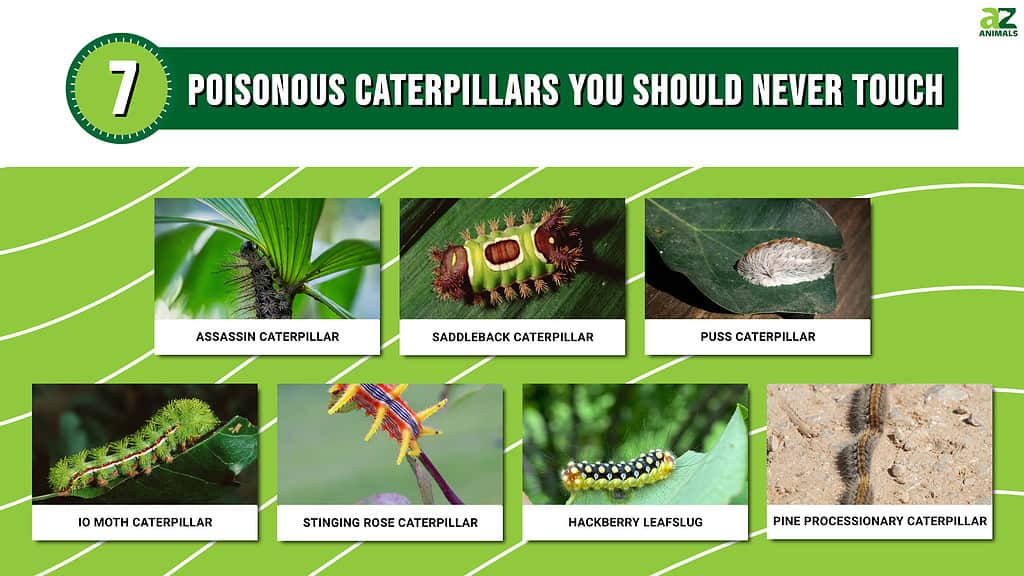
Although the caterpillars on this list may be dangerous or cause discomfort, it is important to note that they will not harm you unless handled. These insects are important parts of the ecosystems that we all live in and are deserving of respect. The best thing to do is to keep a distance when observing and avoid handling them altogether. If you must handle them for some reason, do so with caution and at your own risk.
Assassin Caterpillar (Lonomia obliqua)
The assassin caterpillar is the larval stage of one of several moths known as the giant silkworm moth. This species, Lonomia obliqua, is exceptionally dangerous in its larval form, possessing venom strong enough to severely poison or even kill an adult human. More than a thousand cases of poisoning by this caterpillar occur across South America each year.
This species of caterpillar is covered in many sharp, spiny structures called scoli. The tip of each spine is fragile and breaks off easily on contact, injecting the victim with the potent venom within. Though it takes anywhere from 20 to 100 stings to cause toxicity, each insect bears hundreds or thousands of brittle spines and can cause severe envenoming quite easily. These caterpillars congregate on the lower parts of trees in large groups throughout the day, making accidental envenoming quite easy.
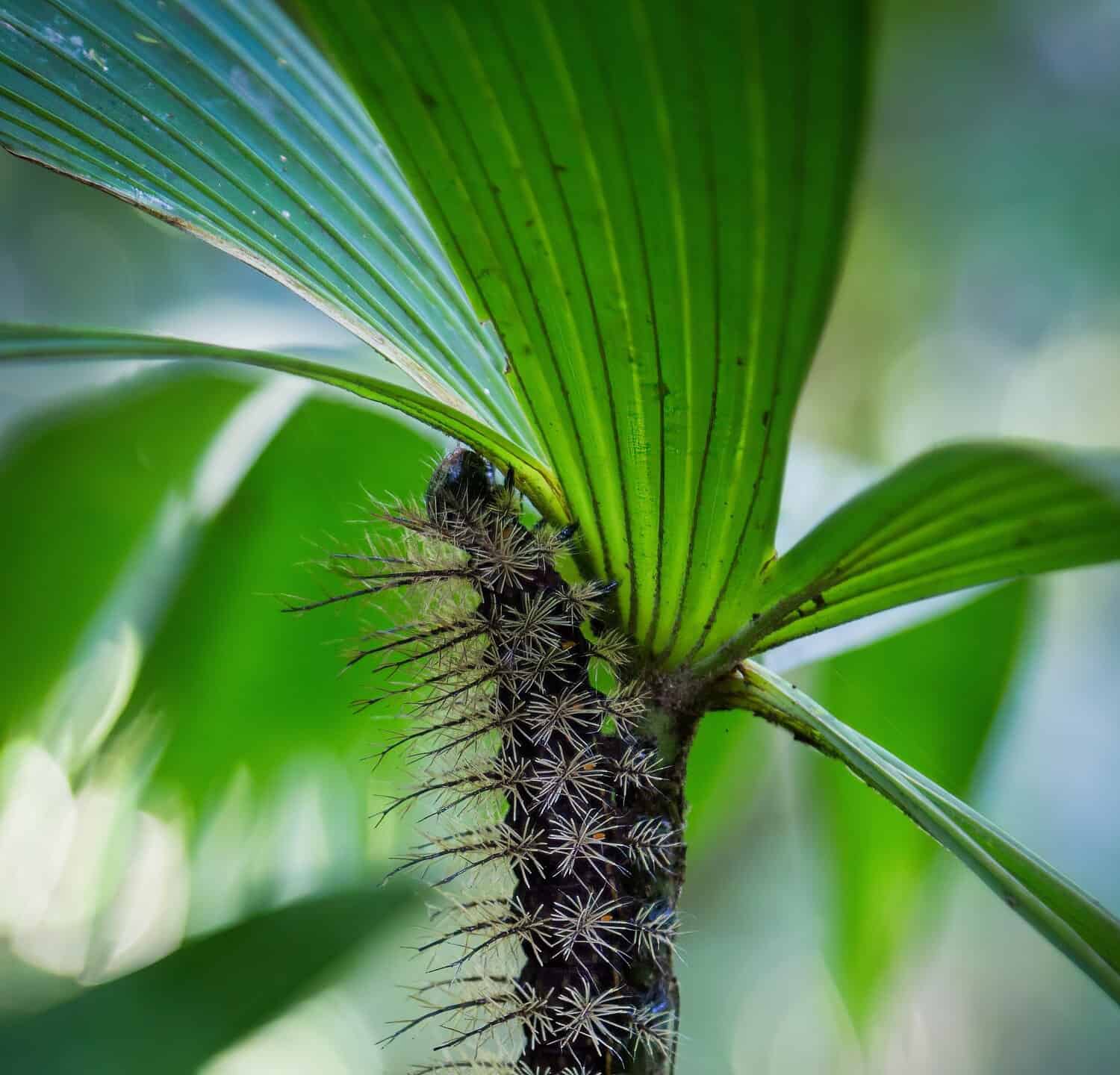
Assassin caterpillars congregate low on the trunks of trees during the day, making accidental envenoming of passersby much more likely.
©Fusco Davide/Shutterstock.com
Saddleback Caterpillar (Acharia stimulea)
The saddleback caterpillar occurs throughout the eastern United States, from Wisconsin southward to Eastern Texas and in every state east of that. It is a slug-like insect that bears aposematic coloration to warn of its toxicity. It gets its name from the saddle-like appearance of the distinct, green and brown markings that cover its midsection. Unlike some who may eat only one or a few food sources, these can feed on more than 40 different plant hosts.
The front, rear, and sides of the saddleback caterpillar are armed with a multitude of spines. When contacted, these spines break off into the victim and release blister-forming compounds that can cause red blood cells to rupture. The venom can cause severe burning, increased sweating, hives, and blisters that can continue to occur for up to five hours. In susceptible individuals, contact with the caterpillars can cause a severe allergic reaction called anaphylaxis, which requires immediate medical attention.
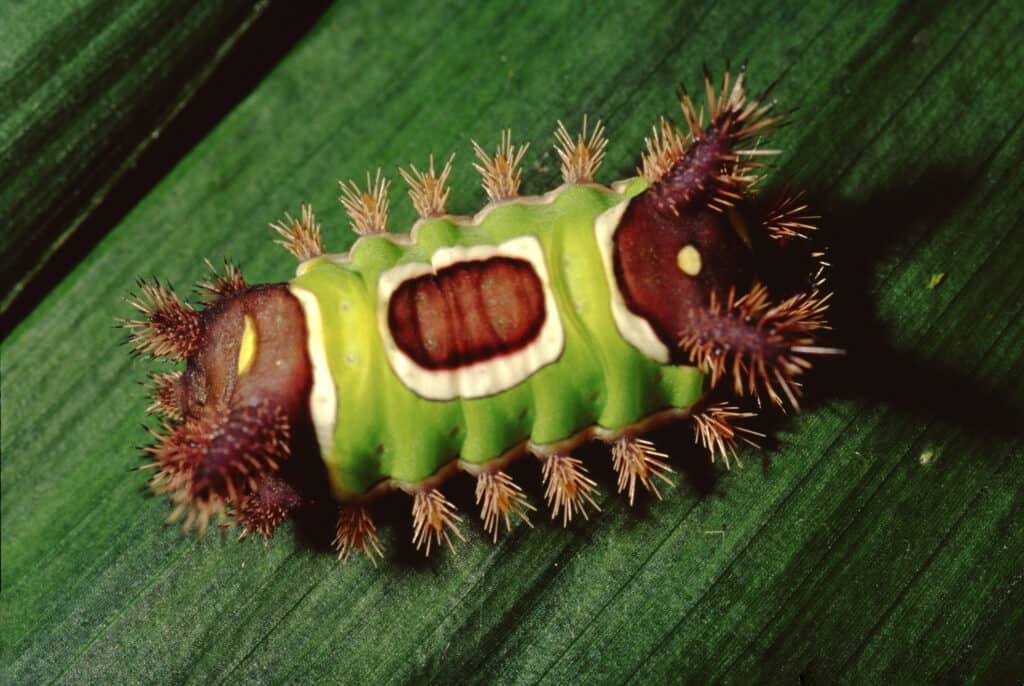
The neon coloration of the saddleback caterpillar is a great example of aposematism. These bright colors warn other animals of the caterpillar’s venomous nature.
©Liz Weber/Shutterstock.com
Puss Caterpillar (Megalopyge opercularis)
The puss caterpillar is the larval form of the southern flannel moth. Though they emerge from their eggs nearly naked, these caterpillars become increasingly covered with hair-like setae after each molt. Mature caterpillars develop a hairy “tail” as well.
Although it may look soft and cuddly, the apparent fur of the puss caterpillar conceals sharp, venomous spines that it uses for self-defense. When a spine tip breaks off in the skin of the victim, it passes on a painful and irritating venom. In humans, this can cause redness at the injection site, nausea, headache, fever, and vomiting. In severe cases, it can cause abdominal pain, muscle spasms, and convulsions. Oftentimes, the spine tips remain embedded in the skin of the victim and must be removed manually.
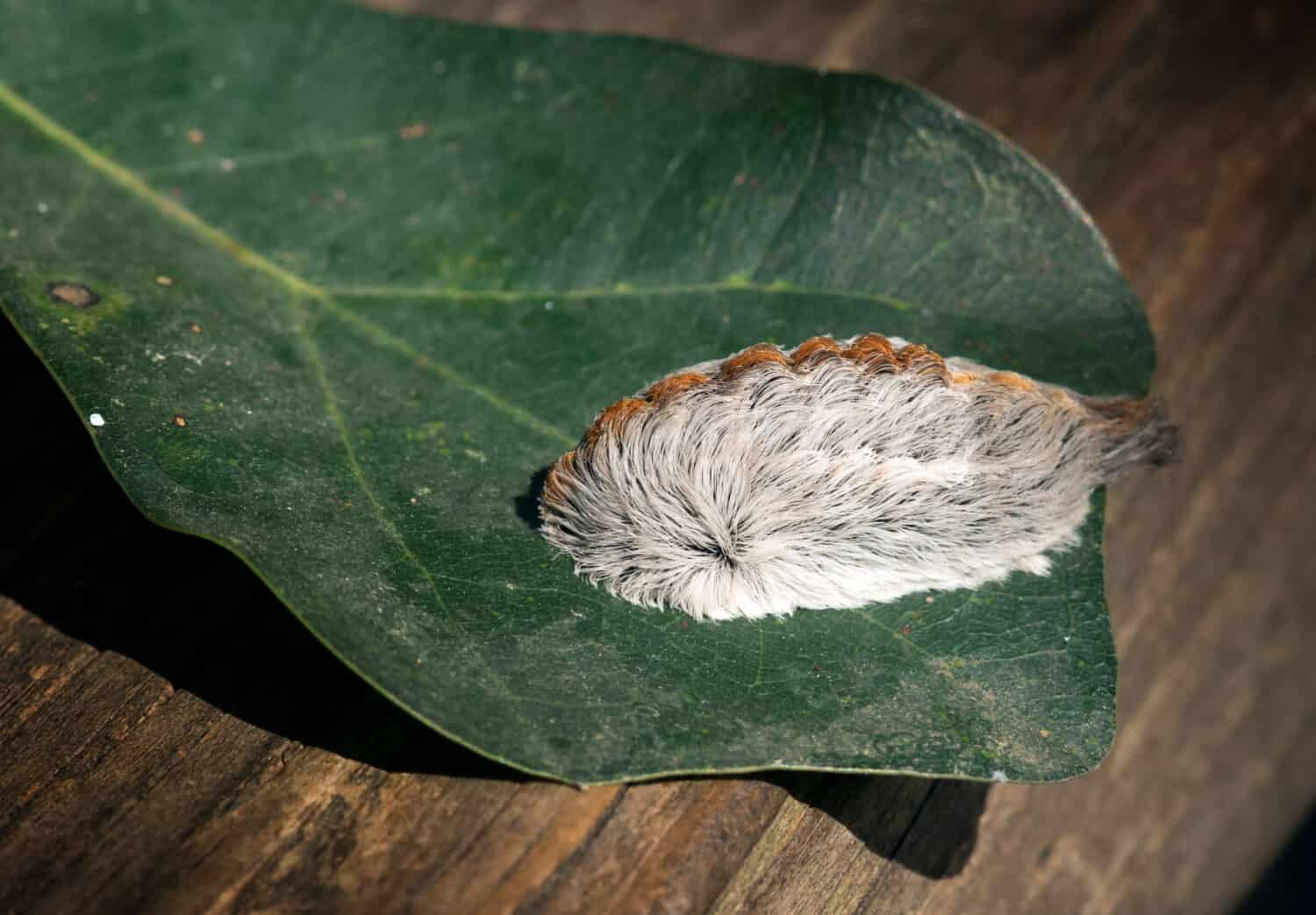
Your first instinct may be to pick up this fluffy-looking caterpillar, but don’t! The soft fur-like setae conceal rows of brittle, venomous spines.
©IrinaK/Shutterstock.com
Io Moth Caterpillar (Automeris io)
The caterpillar of the Io moth, Automeris io, is gregarious, living in close groups. When young, they will often travel together between food sources in single-file processions. These young caterpillars are a reddish-brown color but become lighter, yellowish- or bluish-green as they progress through their life stages. They also become more solitary as they near their final molt into their adult stage.
Many small tuft-like groups of black-tipped spines cover this insect’s entire body throughout all of its larval stages. Envenoming of humans by this type is fairly rare but does occur. When it does occur, the spine tips normally break off into the skin of the victim. Reactions to the resulting venom vary but are usually fairly mild. Symptoms often resolve within a couple of hours and include immediate pain and itchiness, as well as welting and redness, at the injection site. If the spine tips remain in the skin, they may continue to irritate.
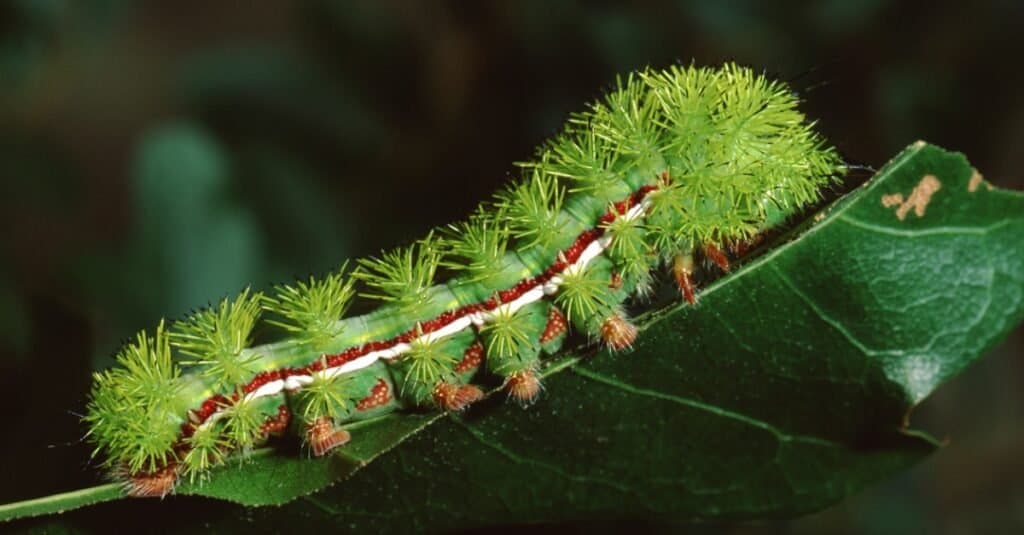
The Io moth caterpillar is gregarious when young, moving in close groups with other members of its species. With age, they become more solitary.
©iStock.com/Weber
Stinging Rose Caterpillar (Parasa indetermina)
These strange, slug-like, neon caterpillars appear throughout the many forests of the eastern United States. Like the saddleback caterpillar, the stinging rose caterpillar also possesses a strongly aposematic color scheme to warn potential predators of its venomous nature. The coloration of individuals can vary, with many individuals being largely yellow rather than red.
The stinging rose caterpillar arms itself with specialized spines, called caltrop spines, that cover its many long, lateral horns. Like other stinging caterpillars, the spines of this species are hollow and break off into the skin of the victim. For its small size, about an inch long, the stinging rose caterpillar possesses surprisingly potent venom. It produces effects in the victim that are similar to those of the saddleback caterpillar. A sting from this species can swell and cause pain for hours or even days.
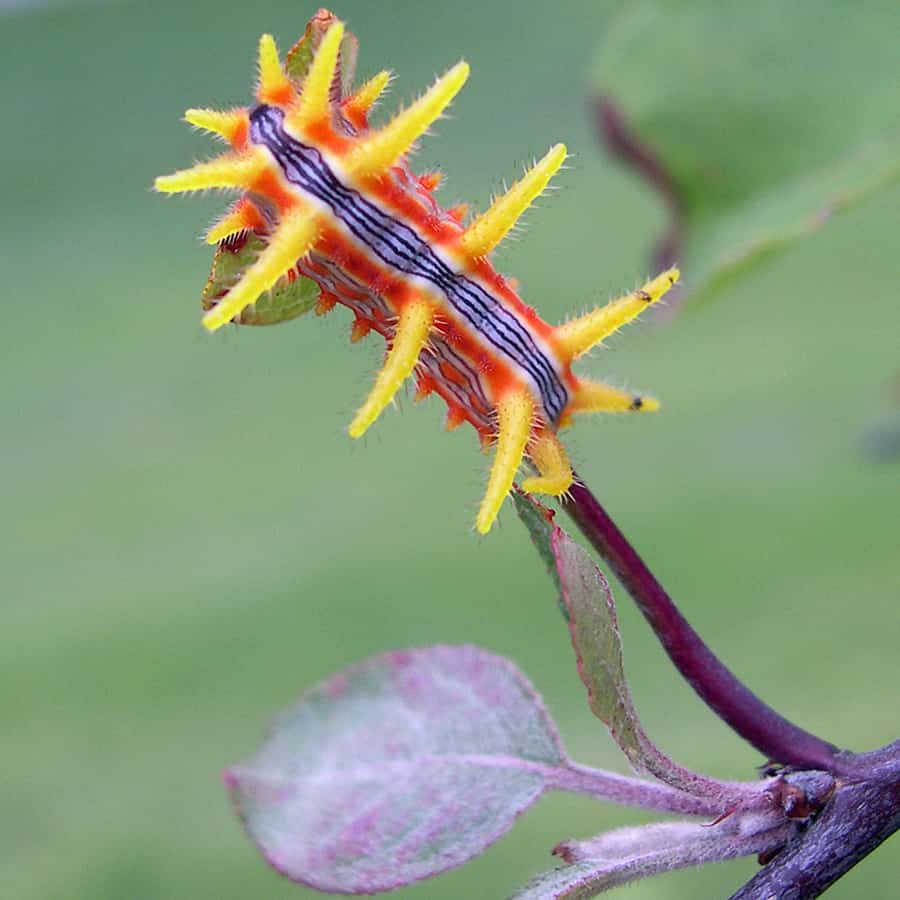
This strange-looking caterpillar is another example of an aposematic insect. The bright, highly contrasting colors and patterns serve to stave off potential predators.
Hackberry Leafslug (Norape cretata)
The hackberry leaf slug is a slug-like caterpillar that, after pupating, becomes the more familiar white flannel moth. Contrary to what its name might suggest, this species of caterpillar is not restricted to the hackberry as a source of food. It will readily feed and deposit eggs on redbuds, beeches, and mimosas as well. The insects themselves usually hang out beneath the leaves of their host plant. When they are ready to pupate, they descend from the tree and create a cocoon just beneath the soil surface.
Like the stinging rose caterpillar, this tiny caterpillar packs a powerful punch when brushed up against it. Breaking the fragile, urticating spines of this species can cause intense pain and blistering at the site of the sting, both of which may last a few or several hours. Many compare the symptoms of the venom to those of a wasp sting.
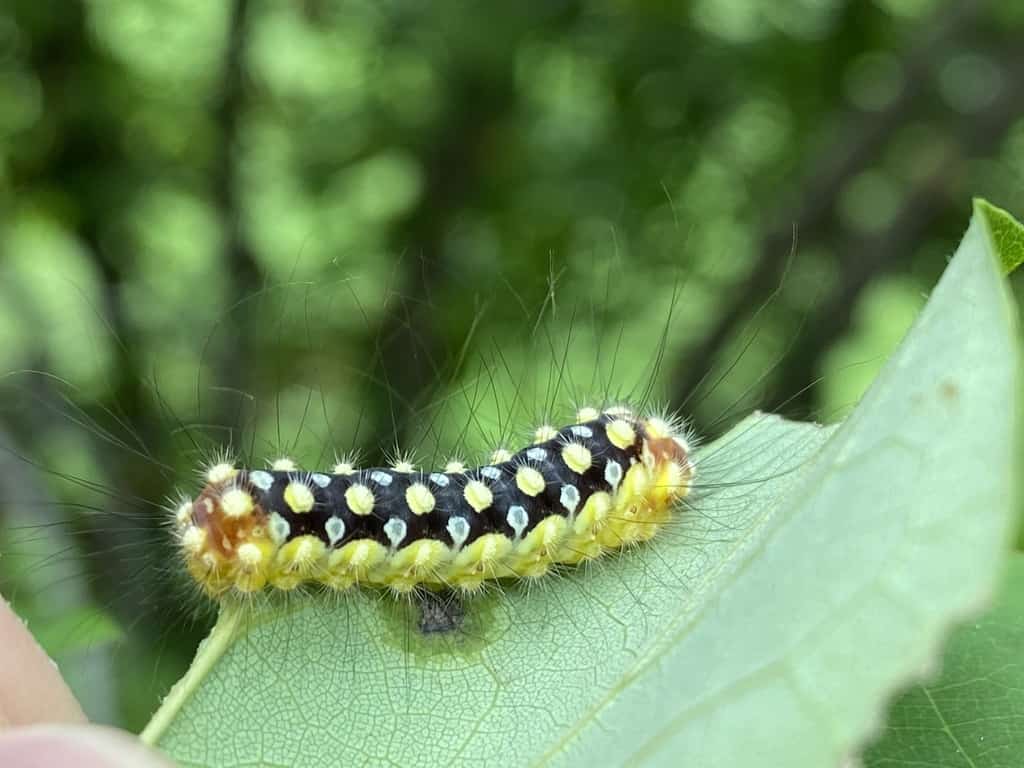
The hackberry leaf slug eats more than just hackberry leaves. Appearing across
North America
, this caterpillar consumes leaves from a variety of tree species, like beeches and redbuds.
Pine Processionary Caterpillar (Thaumetopoea pityocampa)
The pine processionary caterpillar is native to southern Europe, North Africa, and the Middle East. This gregarious insect derives its name from the characteristic linear, procession-like fashion in which it travels in unison with other members of the species. Adult moths lay their eggs at the bases of conifer needles, situated high in the tree canopy. After about a month, they hatch and begin to feed. They have garnered quite a reputation in many parts of Europe where they are considered invasive for their tendency to cause severe defoliation of several conifer species.
These caterpillars, instead of spines, protect themselves using thousands of fine, urticating hairs to pass on their venom. The venom contains an irritating protein, thaumetopoein, which can cause rashes, blisters, and eye and throat irritation. As with the saddleback caterpillar, contact with these can cause a severe anaphylactic reaction in susceptible individuals, requiring immediate medical attention.
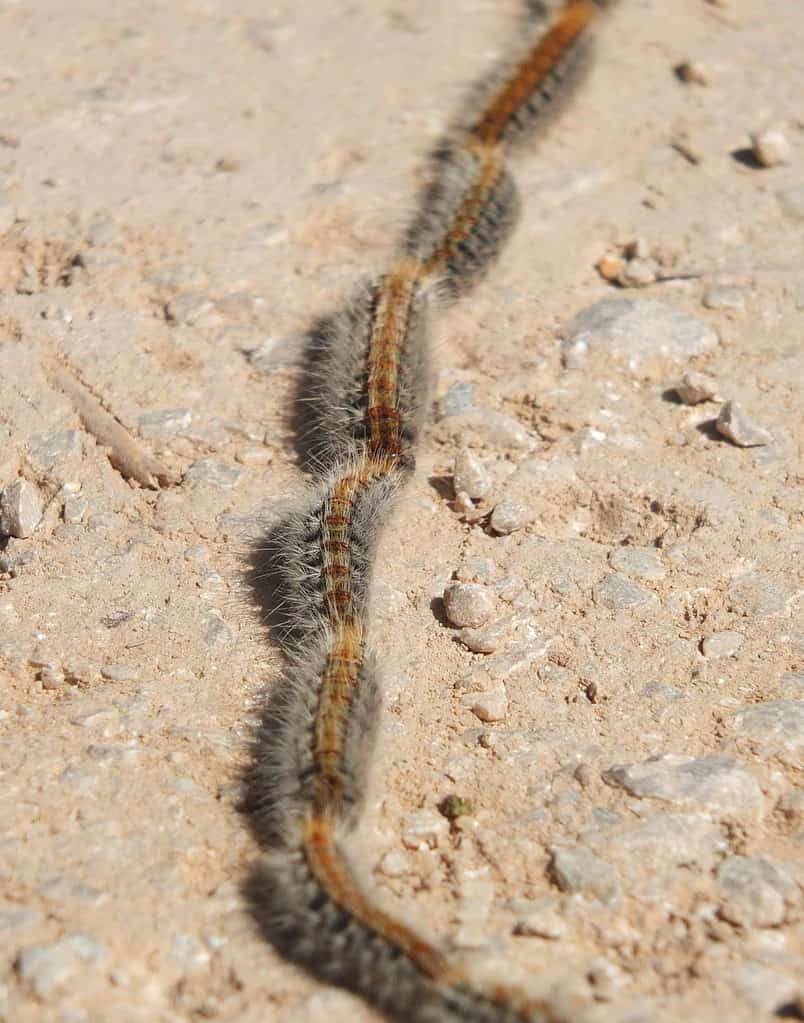
The gregarious pine processionary caterpillar moves together in a single file. Together, they build large nests among the branches of their host pines.
Summary of 7 Poisonous Caterpillars You Should Never Touch
| Caterpillar | Location | |
|---|---|---|
| 1 | Assassin Caterpillar | South America |
| 2 | Saddleback Caterpillar | Eastern United States |
| 3 | Puss Caterpillar | Florida and South Texas |
| 4 | Io Moth Caterpillar | Southern Canada, Eastern U.S. and Eastern Mexico |
| 5 | Stinging Rose Caterpillar | Eastern United States |
| 6 | Hackberry Leafslug | Northeastern Mexico Northward into Parts of the Southwestern United States |
| 7 | Pine Processionary Caterpillar | Southern Europe, North Africa, and the Middle East |
The photo featured at the top of this post is © Hagit Berkovich/Shutterstock.com
Thank you for reading! Have some feedback for us? Contact the AZ Animals editorial team.







